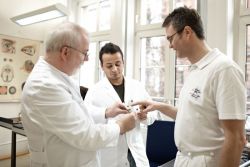Glass or plastic prosthesis?

F. Ad. Müller Söhne uses glass material for the majority of the artificial eyes we produce. The special cryolith glass we use is very well tested and the best suited material considering cosmetic appearance, usability and compatibility. Nor does it release any organic material.
An alternative method to manufacture artificial eyes is to use a plastic, or acrylic material. The main advantage with a plastic prosthesis is that it is basically more durable than one made of glass. It is however considerably more expensive to produce, and requires at least two and sometimes three visits to the ocularist to be fitted, where as an eye prosthesis made of glass requires only one visit.
Since acrylic is an organic material it is not as easily made wet as glass, thus difficult to moisten by tear fluid. This results in dryer eyes with possible irritation to follow. There are different fluids available used to alleviate this characteristic; fluids that are not needed with a prostheses made of glass.
Regarding the lifetime of the eye prostheses it should be noted that although a plastic prostheses is more durable, it must also be changed periodically. The eye socket changes its shape in time and a new prostheses must then be fitted. Since a plastic prostheses is more sensitive to scratching, polishing of the plastic prostheses is recommended. This is not required with one made of glass.